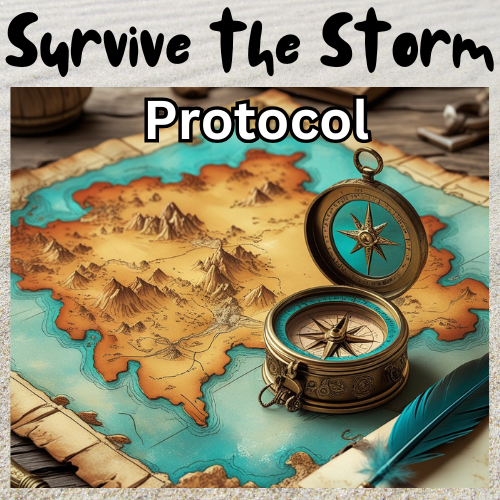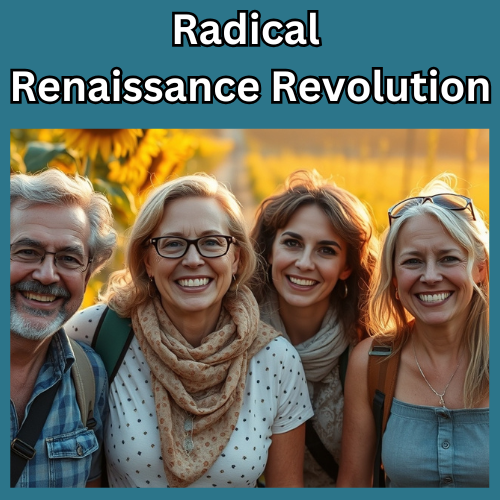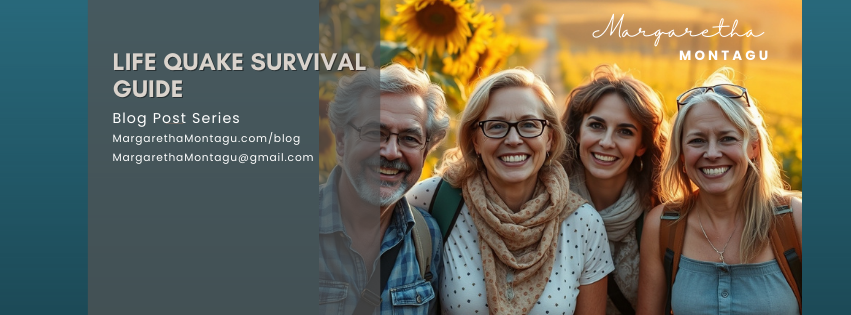A Compass that works even when the Map has been destroyed
In the landscape of our lives, some changes arrive like gentle breezes, while others crash through like seismic events, upending everything we thought was solid. These “life quakes”—major disruptions that shake our foundations—can leave even the most accomplished among us feeling unmoored. Whether it’s an unexpected career shift, the dissolution of a significant relationship, a health crisis, or global upheaval, these profound transitions test our resilience and adaptive capacity.
Yet among the various tools for weathering such storms, one stands out for its accessibility and profound impact: gratitude. Not the superficial “good vibes only” kind that ignores real pain, but rather a deliberate, clear-eyed practice that acknowledges difficulty while simultaneously recognizing what remains intact. For high-achieving professionals accustomed to controlling variables and engineering outcomes, this practice offers something rare—a compass that works even when the map has been destroyed.
When the Ground Shifts: Understanding Life Quakes
Before we dive into gratitude’s transformative potential, let’s acknowledge what happens during major life disruptions. The term “life quake,” popularized by Bruce Feiler, aptly captures the sudden, violent nature of these transitions. Like geological earthquakes, they:
- Strike without warning (or with warnings we’ve chosen to ignore)
- Damage structures we’ve carefully built
- Force us to distinguish between what’s essential and what’s merely convenient
- Create aftershocks that continue long after the initial event
- Eventually lead to new landscapes, sometimes more beautiful than what existed before
For high-performers, these events can be particularly destabilizing. Why? Because success often breeds the illusion of control. We’ve climbed ladders, overcome obstacles, and solved complex problems through intelligence and determination. Then suddenly, we face circumstances where our usual formulas don’t compute. Our professional toolkit—strategic planning, resource allocation, performance metrics—feels inadequate against raw uncertainty.
In these moments, logic alone won’t get you through; you need emotional grounding, compassionate guidance, and a roadmap that speaks to the soul as much as the situation. That’s where the real transformation begins—not just surviving the storm, but rebuilding your life with clarity, confidence, and a renewed sense of self. If you’re standing in the rubble of a LifeQuake and wondering what comes next, the LifeQuake Survival Protocol is your next step toward reinvention, and a life that finally fits.
In a world that feels increasingly unstable — politically, economically, emotionally — what will you do when the rug is pulled out from under you? That’s why I created Survive the Storm — a 7-part online course designed to be a lifeline during a life quake. This is your personal survival toolkit for uncertain times — lovingly crafted and packed with practical tools, emotional support, and soul-nourishing insights to help you stay grounded, resilient, and resourceful when everything around you feels like it’s falling apart. Enrol in How to Survive the Storm Protocol, with or without additional mentoring.

It’s precisely in these moments that gratitude offers not escape, but orientation.
The Counterintuitive Power of Thankfulness
Gratitude during difficulty seems paradoxical. How can one be thankful when facing loss? But this misconception stems from viewing gratitude as merely an emotion rather than a practice—a deliberate shifting of attention that acknowledges reality in its fullness.
Research confirms what ancient wisdom traditions have long taught: gratitude doesn’t just make us feel better momentarily; it actually rewires our neural pathways. Neuroscientist Rick Hanson describes how our brains have a “negativity bias”—we’re velcro for difficulties but teflon for positive experiences. This served our ancestors well for survival but creates psychological challenges in modern life.
Gratitude practice deliberately counterbalances this tendency. When we consciously register positive aspects—even amid crisis—we’re not engaging in denial but rather ensuring our perception includes the complete picture. For the data-driven professional, think of it as correcting for sampling bias in how you process reality.
The Executive Function of Gratitude
For those who’ve built careers on delivering results, gratitude offers concrete advantages during major transitions:
1. Cognitive Flexibility
When we practice gratitude, we activate areas of the brain associated with cognitive flexibility—the ability to adapt our thinking and behaviour in response to changing circumstances. A 2018 study in Frontiers in Human Neuroscience showed that gratitude practice increased activity in the medial prefrontal cortex, which plays a key role in decision-making and emotional regulation.
For professionals accustomed to complex problem-solving, this cognitive flexibility becomes invaluable during transitions. Rather than remaining fixated on what’s been lost, gratitude helps pivot attention toward available resources and possibilities.
2. Stress Reduction Through Perspective-Taking
Major disruptions trigger our threat-response systems, flooding our bodies with stress hormones that impair executive function. Regular gratitude practice reduces cortisol levels and activates parasympathetic responses, literally changing our biochemistry.
This physiological shift enables clearer thinking. As any experienced negotiator knows, decisions made from a reactive state rarely yield optimal outcomes. Gratitude provides the physiological conditions for strategic rather than panicked responses.
3. Social Resource Activation
Success rarely happens in isolation, yet many high-achievers struggle with vulnerability and asking for help. Gratitude naturally strengthens social connections by:
- Making us more aware of support we’ve received
- Increasing our likelihood of reaching out when needed
- Enhancing our attractiveness as potential collaborators
- Creating positive reciprocity cycles
During major transitions, these social resources often determine outcomes more than individual capabilities. The leader who can gracefully activate their network finds solutions unavailable to the isolated striver.
Practical Applications: Gratitude as Strategic Response
How does this translate into practical approaches for navigating life’s major disruptions? Consider these evidence-based strategies, adapted for the professionally accomplished:
Strategic Attention Allocation
Just as you would allocate resources in a business context, consciously direct your attention toward assets rather than only deficits. This isn’t about ignoring problems but ensuring you’re working with complete data.
Try this: For every challenge you identify during a transition, identify three intact resources. These might be skills, relationships, material assets, or opportunities. The ratio matters—we need multiple positive elements to balance each negative one due to our innate negativity bias.
Gratitude Journaling with Specificity
The effectiveness of gratitude journaling depends on specificity and novelty. Rather than generic entries (“I’m grateful for my health”), successful professionals will benefit from detailed observation:
“Today I’m grateful that my accumulated experience with scenario planning is helping me envision multiple pathways forward, even though the future is uncertain.”
This specificity connects gratitude to your professional identity and competencies, reinforcing self-efficacy during times when confidence may waver.
Counter-factual Thinking
This approach involves consciously considering how circumstances could be worse—a technique used in both strategic planning and cognitive therapy. By imagining less favorable scenarios, we gain perspective on our current reality.
For example, during a career transition, you might reflect: “While this reorganization was unexpected, I’m grateful it’s happening at a point when I have financial reserves and a strong professional reputation, unlike earlier in my career when I would have been more vulnerable.”
This isn’t diminishing actual difficulties but contextualizing them within broader possibilities.
Benefit-Finding
Distinguished from toxic positivity, benefit-finding is the deliberate search for legitimate growth opportunities within challenges. This approach has been studied extensively in health psychology, showing remarkable impacts on recovery and resilience.
The key distinction: benefit-finding acknowledges the genuine difficulty while also recognizing potential positive outcomes. It maintains the both/and complexity that mature professionals understand characterizes most situations.
When the Corporate Ladder Falls: Case Studies in Professional Transitions
Consider these scenarios where gratitude practices transformed professional upheaval:
The Unexpected Departure
Maria, a senior executive, faced sudden dismissal after her company merged with a competitor. Initial shock and anger threatened to damage her professional relationships and reputation. By implementing a structured gratitude practice, she:
- Recognized the skills she’d developed that would transfer to new contexts
- Appreciated the professional network she’d built over two decades
- Found unexpected freedom in exploring new directions without institutional constraints
Rather than becoming bitter, Maria approached her transition with a sense of earned wisdom and openness. Six months later, she had launched a successful consultancy serving her former industry, with several former colleagues as clients who valued her institutional knowledge and fresh perspective.
The gratitude practice didn’t eliminate her initial grief, but it prevented her from becoming stuck in it. She later reflected that losing her position ultimately freed her from golden handcuffs she hadn’t recognized were limiting her potential.
The Health Crisis Pivot
James, a driven entrepreneur, experienced a serious health event at 45 that required him to fundamentally reconsider his work patterns. Initially devastated by physical limitations, he began a daily gratitude practice focused on:
- The financial stability his previous work had created
- The talented team he’d assembled who could carry projects forward
- The perspective shift that allowed him to refocus on long-overlooked priorities
This reorientation led James to restructure his company around sustainable growth rather than constant expansion. Three years later, both profitability and employee satisfaction had increased, while he worked fewer hours with greater impact.
James didn’t deny his physical challenges or the need to adapt. Rather, gratitude helped him recognize assets he’d overlooked while caught in the hamster wheel of constant achievement.
Beyond Personal Resilience: Gratitude as Leadership Strategy
For senior professionals, gratitude practices extend beyond personal resilience to become powerful leadership tools during organizational transitions. Leaders who model grateful perspectives:
- Create psychological safety that enables innovation during uncertainty
- Reduce trauma responses among team members facing disruption
- Maintain morale and engagement when external conditions challenge motivation
- Build organizational narratives that integrate both challenges and strengths
Research from the Harvard Business School demonstrates that expressions of gratitude from leaders increase employee productivity and engagement by 50% or more. During times of major transition, this impact becomes even more pronounced.
The Limitations: When Gratitude Isn’t Enough
Intellectual honesty requires acknowledging gratitude’s limitations. It isn’t a cure-all and works best as part of a comprehensive approach to major life transitions. Be aware of:
- The risk of premature gratitude that short-circuits necessary grief
- Potential for gratitude practices to be weaponized (“just be grateful for what you have”)
- Cultural and personality differences in how gratitude is expressed and experienced
- Situations where action must precede feeling (sometimes we need to make changes before gratitude becomes accessible)
For professionals facing truly catastrophic circumstances, gratitude may need to start with the most fundamental acknowledgements: “I’m still here. I can still make choices. I have survived difficult things before.”
Building the Gratitude Muscle Before the Earthquake
The most effective approach involves developing gratitude practices before major disruptions occur. Like any capability, gratitude strengthens with consistent application. Consider:
- Regular reflection on the conditions and individuals that enable your success
- Explicit acknowledgement of team contributions rather than solo achievement narratives
- Conscious attention to small pleasures that might otherwise go unnoticed
- Systems for tracking progress and growth, not just outcomes and targets
These practices build neural pathways that become accessible during crises—when we need them most but find them hardest to access.
Conclusion: Gratitude as Mature Optimism
For accomplished professionals navigating life’s inevitable upheavals, gratitude offers not blind optimism but its more sophisticated cousin: clear-eyed hope. It acknowledges complexity and challenge while simultaneously recognizing capacity and connection.
In a business landscape characterized by volatility and disruption, this orientation becomes not merely a personal coping mechanism but a strategic advantage. Those who can maintain perspective during uncertainty make better decisions, preserve key relationships, and identify opportunities overlooked by others caught in reactivity.
The next time your professional or personal landscape shifts unexpectedly, consider what remains standing amid the rubble. The practice won’t eliminate the need to rebuild, but it will help ensure you’re building on the strongest remaining foundation rather than the most visible damage.
When the earthquake comes—and it will—gratitude doesn’t stop the ground from shaking. But it does help us notice where we can still plant our feet.

Ready to start again, stronger than ever before? This quiz will help you find out. It is not just about measuring where you are right now; it’s about shining a light on the areas of your life that feel meaningful, as well as those that might need attention. It’s an opportunity to reflect, recalibrate, and take steps toward a life that’s not only successful but profoundly fulfilling. Take The Quiz
In a world that feels increasingly unstable — politically, economically, emotionally — what will you do when the rug is pulled out from under you? That’s why I created Survive the Storm — a 7-part online course designed to be a lifeline during a life quake. This is your personal survival toolkit for uncertain times — lovingly crafted and packed with practical tools, emotional support, and soul-nourishing insights to help you stay grounded, resilient, and resourceful when everything around you feels like it’s falling apart. Enrol in How to Survive the Storm Protocol, with or without additional mentoring.


“I am an experienced medical doctor – MBChB, MRCGP, NLP master pract cert, Transformational Life Coach (dip.) Life Story Coach (cert.) Stress Counselling (cert.) Med Hypnotherapy (dip.) and EAGALA (cert.) I may have an impressive number of letters after my name, and more than three decades of professional experience, but what qualifies me to excel at what I do is my intuitive understanding of my clients’ difficulties and my extensive personal experience of managing major life changes using strategies I developed over many years.” Dr M Montagu

